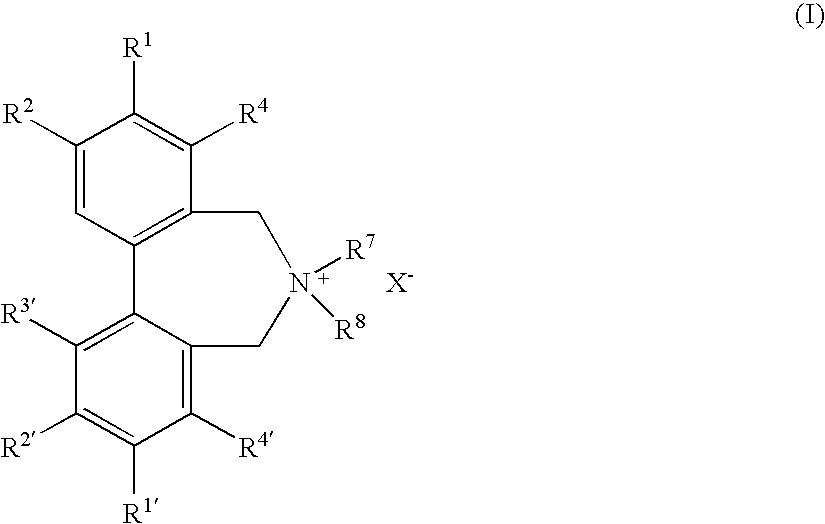Optically active quaternary ammonium salt having axial asymmetry and process for producing alpha-amino acid and derivative thereof with the same
a technology of quaternary ammonium salt and axial symmetry, which is applied in the direction of organic compound/hydride/coordination complex catalyst, physical/chemical process catalyst, organic compound/hydride catalyst, etc., can solve the problems of low temperature conditions, slow reaction speed, and undiscovered practical methods, and achieves a simple structure and production in a fewer number of steps.
- Summary
- Abstract
- Description
- Claims
- Application Information
AI Technical Summary
Benefits of technology
Problems solved by technology
Method used
Image
Examples
reference example 1
Synthesis of Starting Material (Compound 2a) for Synthesizing Quaternary Ammonium Salt
[1708]
[1709]N-Bromosuccinimide (NBS) (21.36 g, 120 mmol) was added to a solution of 3,4,5-trimethoxy benzoic acid (compound 1a) (21.22 g, 100 mmol) in CHCl3 (200 mL). This solution was heated under reflux for 8 hours. Then, the CHCl3 was removed under reduced pressure, and the residue was dissolved in a 1 N NaOH solution (150 mL). After washing with CHCl3 (15 mL) three times, this alkaline solution was acidified with concentrated hydrochloric acid. The resulting precipitates were filtered off, washed with 1 N HCl, and dried to give the title compound 2a (2-bromo-3,4,5-trimethoxybenzoic acid) (23.3 g, 80 mmol / yield: 80%). The NMR spectrum of the obtained compound 2a is shown in Table 1.
TABLE 1NMR spectrum of compound 2a400 MHz 1H NMR (CDCl3) δ 7.40 (1H, s, Ar—H), 3.97 (3H, s, OCH3),3.91 (3H, s, OCH3), 3.90 (3H, s, OCH3).
reference example 2
Synthesis of Starting Material (Compound 3a) for Synthesizing Quaternary Ammonium Salt
[1710]
[1711]Under an argon atmosphere, the compound 2a obtained in Reference Example 1 (2.33 g, 8.0 mmol) and thionyl chloride SOCl2 (6 mL) were placed in a two-necked flask. This reaction mixture was then heated under reflux for 4 hours. Then, the excess thionyl chloride was evaporated under reduced pressure. THF (15 mL), pyridine (1.5 mL), and (S)-1,1′-bi-2-naphthol (1.14 g, 4.0 mmol) were added to the residue. After reflux for 3 hours, 1 N NaOH followed by 1 N HCl were added to the reaction mixture and extracted with ether. The separated organic layer was dried over Na2SO4 and concentrated. The residue was purified by silica gel chromatography (ether / hexane=1 / 1 as eluent) to give the title compound 3a ((S)-2,2′-bis(2-bromo -3,4,5-trimethoxybenzoyl)-1,1′-binaphthalene) (3.33 g, 4.0 mmol) in a quantitative yield. The NMR spectrum of the obtained compound 3a is shown in Table 2.
TABLE 2NMR spectrum ...
reference example 3
Synthesis of Starting Material (Compound 5a) for Synthesizing Quaternary Ammonium Salt
[1712]
[1713]A suspension of activated Cu powder (11.8 g, 184 mmol) in DMF (60 mL) was heated to a gentle reflux with vigorously stirring. Then, a solution of the compound 3a (3.33 g, 4.0 mol) obtained in Reference Example 2 in DMF (50 mL) was added to this mixture over seven hours under an argon atmosphere. After heating at reflux for 12 hours, the reaction mixture was filtered and DMF was removed under reduced pressure. The residue was partially purified by silica gel column chromatography (hexane / ethyl acetate: 2 / 1 as eluent) to give a mixture of an intramolecular coupling product (compound 4a) and a debrominated byproduct. This was used as is in the following reduction process without further purification.
[1714]The compound 4a obtained above (partially purified product) was added dropwise to a suspension of LiAlH4 (0.760 g, 16 mmol) in THF (15 mL) at 0° C. The reaction mixture was stirred at roo...
PUM
| Property | Measurement | Unit |
|---|---|---|
| Fraction | aaaaa | aaaaa |
| Fraction | aaaaa | aaaaa |
| Substance count | aaaaa | aaaaa |
Abstract
Description
Claims
Application Information
 Login to View More
Login to View More - R&D
- Intellectual Property
- Life Sciences
- Materials
- Tech Scout
- Unparalleled Data Quality
- Higher Quality Content
- 60% Fewer Hallucinations
Browse by: Latest US Patents, China's latest patents, Technical Efficacy Thesaurus, Application Domain, Technology Topic, Popular Technical Reports.
© 2025 PatSnap. All rights reserved.Legal|Privacy policy|Modern Slavery Act Transparency Statement|Sitemap|About US| Contact US: help@patsnap.com



